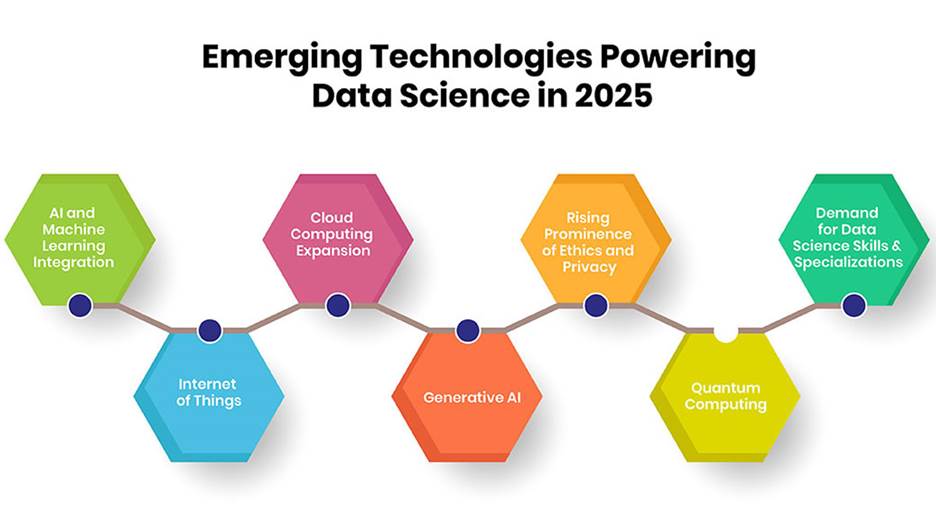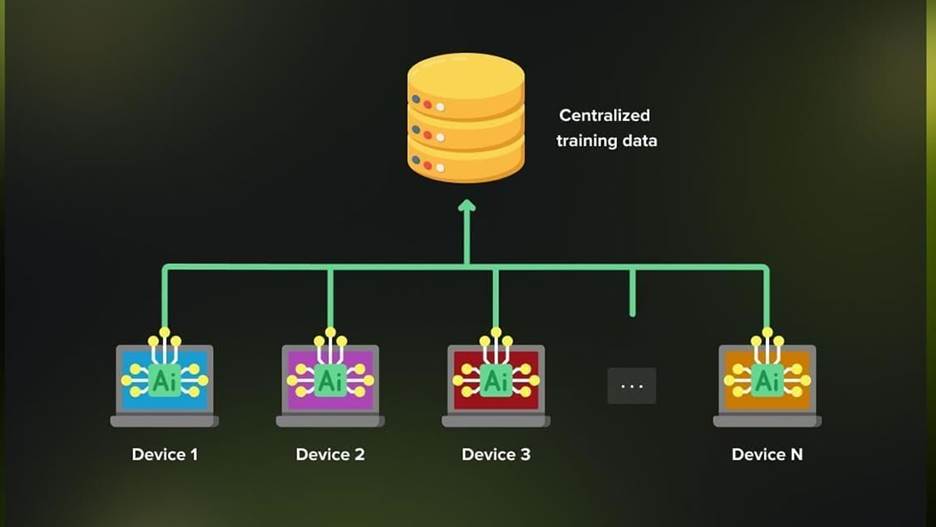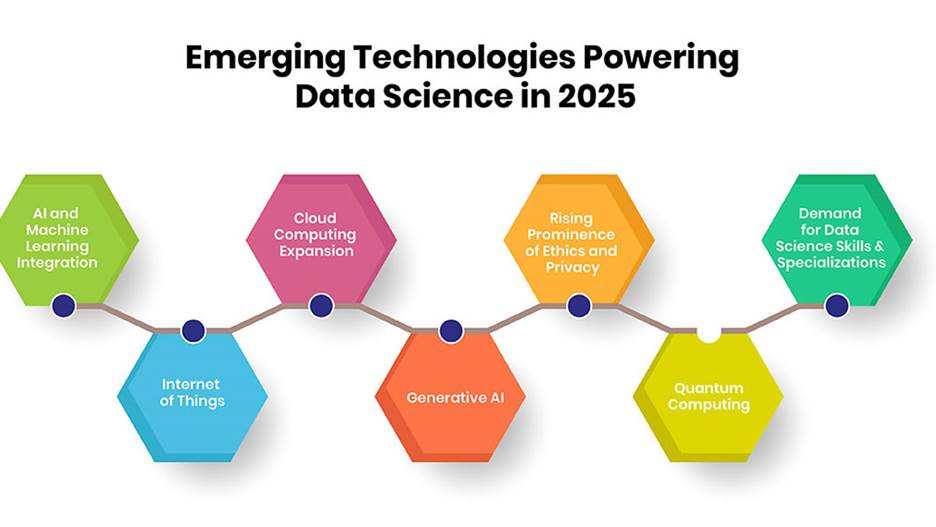Data science is changing at a quicker pace than ever before. In the last ten years, companies have employed data to make decisions, automate, and know their customers. Now, in 2025, data science is a force behind artificial intelligence, automation, and decision-making in all industries. Companies are no longer arguing whether they need data science. Today, they are arguing about how to keep pace with the most recent data science trends and implement them.

There are a few hard-hitting innovations this year that are defining the future of data science. They are AutoML, synthetic data, federated learning, and explainable AI (XAI). These trends, collectively, are revolutionizing the way data is gathered, stored, and utilized to generate insights. We will discuss these innovations and why they are important in 2025.
Why Data Science Trends Matter in 2025
The volume of information generated globally is staggering. The globe will generate over 180 zettabytes of information by 2025. Enabling this enormous flow requires smarter technologies, automation, and secure practices. All this while, the firms must make faster, fact-based decisions without compromising users’ privacy and regulatory adherence.
That is precisely why it is important to monitor data science trends. New technologies are not hype; they have an instant impact on the way companies build products, create strategies, and interact with customers. You may be a data scientist, an engineer, or a business leader, but to be cognizant of these trends puts you ahead of the game.
Automating the Data Science Process
Among the most talked-about data science trends is AutoML (Automated Machine Learning). Traditionally, building machine learning models has required knowledge of algorithms, feature engineering, and hyperparameter tuning. AutoML is flipping these processes on their head by automating them.
In 2025, AutoML platforms will be utilized by industries in enormous numbers. Industries no longer require large teams of experts to validate models. AutoML tools, rather, enable experts with little or no coding or statistical knowledge to build, validate, and deploy models at high velocity.
Why AutoML Matters in 2025
- Accessibility: AutoML enables non-specialists to access sophisticated machine learning.
- Efficiency: It is time-efficient in training and testing models.
- Scalability: It is possible to deploy solutions faster in more departments.
From healthcare diagnostics to investment prediction, AutoML is helping companies make faster decisions and cut costs.
Synthetic Data: Empowering AI through Data Made Artificially
One of the biggest data science problems has always been the availability and quality of data. It is too expensive, time-consuming, or privacy-restricted to collect lots of real-world data in most sectors. That is where synthetic data comes to the rescue.
Synthetic data is man-made data that mimics the pattern and structure of real data. It doesn’t share confidential data. So far, till 2025, this has gone mainstream. Synthetic data is being utilized by technology companies, health organizations, and financial institutions to train AI models and preserve user privacy.
Benefits of Synthetic Data in 2025:
- Privacy Protection: No possibility of disclosure of individual data.
- Cost Savings: Avoids the use of costly, large-scale data gathering.
- Balanced Datasets: Facilitates production of diverse datasets to prevent algorithmic bias.
For example, manufacturers of autonomous cars produce millions of simulated driving scenarios based on artificial data. This improves car safety without relying on real-world road tests. Similarly, artificial medical records in healthcare allow for research without compromising patient confidentiality.
Federated Learning: Train Models Without Sharing Data
In the face of increasing data privacy concerns, federated learning has come as a breakthrough. Rather than transferring data to central servers for training, federated learning allows AI models to train on local devices directly. The models train on decentralized data sets and transfer only the learnings, not the original data.

In 2025, this approach is gaining momentum in regions where privacy and compliance are of utmost importance. Technology companies are using federated learning on smartphones and Internet of Things devices to improve predictive text, personalized suggestions, and security settings without transmitting sensitive user information.
Advantages of Federated Learning
- Enhanced Privacy: Users’ data never leaves the device.
- Regulatory Compliance: Adherent to strict data protection laws like GDPR and HIPAA.
- Improved Personalization: Models learn from real user behavior securely.
Federated learning is poised to become the norm in applications from healthcare diagnosis to mobile applications and financial services fraud detection.
Explainable AI (XAI): Building Trust in Machine Learning
AI is now incredibly powerful, but the only issue that remains is transparency. Most machine learning algorithms, and especially deep learning algorithms, are “black boxes,” making predictions without explaining why they made that prediction. It is a lack of interpretability that creates trust issues, particularly in healthcare, finance, and law.
In 2025, XAI is the most significant trend in data science. XAI is a move towards creating more explainable, transparent, and responsible AI models. Instead of providing only predictions, these models provide an explanation that can be understood by humans.
Why Explainable AI is Important
- Trust and Responsibility: Decision-makers ought to be told why a decision was made by an AI model.
- Regulatory Requirements: Most countries’ regulations now require explainability of AI decisions.
- Bias Detection: XAI assists in detecting and removing biases in machine learning models.
For instance, in finance, XAI translates approval for a loan into simple human language. In healthcare, doctors can see why an AI system has recommended a particular treatment. Transparency between humans and AI encourages trust.
Other Future Trends in 2025 Data Science
Besides AutoML, synthetic data, federated learning, and XAI, there are several other trends shaping the data science space this year:
- Edge AI: Running AI models on endpoints instead of cloud servers to enable faster response time.
- Datapost: Streamlining data processes and management for increased productivity and collaboration.
- Real-Time Analytics: A Growing necessity for real-time data in industries like finance, logistics, and e-commerce.
- AI Governance: Ensuring equitable use of AI through ethics frameworks, compliance, and equity.
Quantum Machine Learning: Only just beginning, but potentially already able to solve difficult problems beyond the reach of classical computing.
The Business Consequences of Data Science Trends
Companies embracing these data science trends are reaping enormous competitive advantages. AutoML costs companies less and is more effective. Synthetic data is compliant while facilitating innovation. Federated learning offers personalization without compromising on privacy. And XAI builds customer trust. Companies that fall behind may fall further behind. With the global economy more electronic than ever, information-based decisions are no longer discretionary; they’re a requirement.
Future Directions: Where Data Science Is Heading
Heading into 2025 and beyond, data science will move in three general directions:
- More Automation: Even more tasks will become automated, and it will be simpler for companies to integrate AI.
- Tighter Ethics and Privacy Regulations: With public concerns growing stronger, regulations on the use of AI and data will tighten.
- More Human-AI Interaction: AI would not substitute human beings but work with humans to enhance decision-making.

The future of data science is not about the technology at all, but about building systems that are transparent, ethical, and good for society.
Conclusion
Data science is driving innovation today. The most influential data science trends in 2025 are AutoML, synthetic data, federated learning, and explainable AI. These technologies are revolutionizing industries by making AI more accessible, privacy-aware, and more trustworthy. For businesses and professionals, it is no longer a matter of choice to keep pace with these trends. It is the recipe for success in the information age.
1. What are the largest data science trends in 2025?
The prevailing trends include AutoML, synthetic data, federated learning, explainable AI, edge AI, and real-time analytics as well.
2. How does AutoML help businesses?
AutoML does away with the need to handcraft and fine-tune machine learning models, opening up advanced analytics to non-technical individuals and saving time.
3. Why is synthetic data important?
Synthetic data enables realistic training sets without revealing sensitive information, while still having bias minimization and privacy within AI models.
4. What is federated learning used for?
Federated learning allows AI models to learn from decentralized data without needing to relocate it, hence regulation-compliant and privacy-preserving.
5. How does trust arise in explainable AI?
Explainable AI provides human-interpretable explanations for machine learning predictions, thereby making AI transparent, equitable, and accountable.

